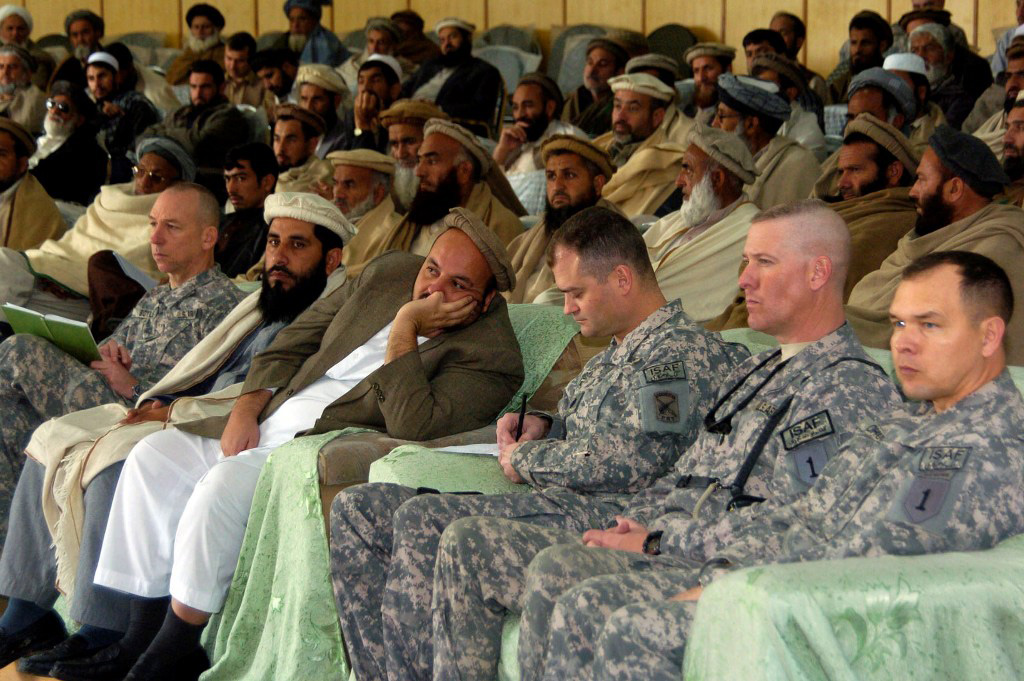For Waleed Shiraz, 22, life in northwest Pakistan was once uncomplicated. A former student of Political Science and foreign languages, Shiraz recalls days spent studying in the hujra, a traditional guest drawing room – he liked it there because it was “peaceful and quiet.” The oldest of three brothers, Shiraz hoped to pursue his Master’s degree and help his younger siblings through school. He could not have imagined that, with the push of a button far away in the United States, his father’s life, his own physical mobility, his future, and the future of his family, would all come to an end.
“[When we got hit], my father’s body was scattered in pieces and he died immediately, but I was unconscious for three to four days,” Shiraz said in a personal testimony for Living Under Drones, a project which seeks to inform the American public about the reality of drone warfare. “[Since then], I am disabled…I have been completely ruined…[My brothers] can’t go to school because I can’t afford to support them…they are home most of the day and they are very conscious of the fact that drones are hovering over them. [The presence of drones] intimidates them.”
Combat drones, or unmanned combat air vehicles (UCAVs), are armed aircraft without human pilots on board. Flying either autonomously or via remote control, these drones operate in real-time, and allow operators to carry out missile and bomb strikes safely from the ground or another vehicle. They are lighter and less expensive than manned aircrafts, and they eliminate the danger faced by jet pilots.
But that doesn’t mean they’re safe – at least, not for the civilians below.
The Long War Journal, a news group that provides reporting and analysis of the war on terror, puts total Pakistani deaths since 2006 as a result of U.S. drone strikes at 2,583. 142 of them were reported civilians.
The Bureau of Investigative Journalism reports a higher death count – since 2004, approximately 3,300 people have been killed in total, ranging from 473 to 889 civilians, and 176 of them were children.
These statistics are staggering; and yet, even they do not represent the entire picture. Only when we examine the distinction between civilians and combatants, or “militants,” as they are so frequently referenced in the press, does the grim reality begin to take shape. According to a New York Times report, President Obama, a Nobel Peace Prize winner, has used a highly controversial method for counting civilian death tolls, which, in effect, considers all military-age males in a strike zone to be combatants, “unless there is explicit intelligence posthumously proving them innocent.”
This “qualification” for death by drone is frighteningly broad. According to Obama’s drone rulebook, the CIA can effectively kill any young man it wants and the papers will read: “Militant killed in Pakistan.” “Civilian” death counts will remain comparatively low and deceiving to the public. No harm done. No sense crying over killed militants.
Mere days after President Obama declared that the drone campaign in Pakistan was a “targeted, focused effort,” an investigation by the Bureau of Investigative Journalism was published in the Sunday Times of London, the revelations of which were nothing short of appalling. According to the findings, the CIA has embraced a strike tactic called the “double tap.” A chosen tactic of Hamas, it involves setting off a primary device, waiting for police, rescuers (and possibly loved ones) to arrive at the scene, and then setting off a larger device, killing everyone in the area. [iv]
If this information is shocking, it may be because the Obama administration has operated under intense secrecy regarding its drone program – it is officially covert, it is rarely given public address, and the President’s explanation of the collective reasoning behind it has been limited at best. In what was perhaps the most transparent discussion to date on the subject, Obama responded to a question in a “hangout” on Google’s social network, Google+, by stating that targeted al-Qaeda suspects lived in “tough terrain” along the Pakistani-Afghan border that would require more “intrusive military action” were it not for drones. Aside from this rationale, the American public hears the same talking points repeated over and over again: “My job, first and foremost, is keeping the American people safe,” the President says.
One thing is clear: Obama’s tactics are too closed off, too error-ridden, and too legally ambiguous to deliver any real measure of safety. If he is keeping terrorism at bay for the time being, he is undermining our security in the long-term by setting a dangerous legal and ethical precedent. With the U.S. carrying out nearly 300 predator drone strikes in Pakistan without obtaining the consent of that state, all while killing innocent people and writing it off as an inevitable cost of combat, who is to say other powerful states cannot do the same? When it comes to drone warfare, we have lost all semblance of a moral high ground, and dispelled any illusions of our benevolence. What’s worse, we are breeding resentment – exactly the kind of resentment that has the potential to transform young men into terrorists. According to a 2012 poll by the Pew Research Center’s Global Attitude Project, 74% of Pakistanis consider the United States an enemy.
President Obama is responsible for the rapid acceleration of the drone war in Pakistan, but he is not responsible for starting it. Former President George W. Bush was the first to send unmanned aircraft into the area for the purpose of killing supposed terrorists following 9/11. Since taking office, however, Obama has expanded the program to unprecedented levels, enacting it in Yemen and Somalia. Where Bush-era strikes largely targeted al-Qaeda leaders, the CIA under Obama has killed members of offshoot groups, low-level soldiers, and even American citizens.
Anwar al-Awlaki was an American-born Muslim cleric and a prominent leader in al-Qaeda’s affiliate organization in Yemen. Mr. Awlaki, an English-speaker, frequently used the Internet to promote violent jihad against the U.S. His online lectures were linked with several terrorist plots, including that of Umar Farouk Abdulmutallab, who, in December 2009, attempted to blow up an airplane with a bomb hidden in his underwear. The attempted May 2010 Times Square bombing by Faisal Shahzad was also reportedly inspired in part by al-Awlaki’s teachings.
On September 30, 2011, an American drone aircraft killed al-Awlaki in Yemen, as well as Samir Khan, a fellow American citizen who was traveling with him. Khan was an editor for al-Qaeda’s online jihadist magazine, but was not on the target list.
The administration’s targeted and secret killing of the two men caused a firestorm among human rights groups. Al-Awlaki and Khan were American citizens, which meant that, under the Constitution, they were entitled to due process of law. The decision on the part of the Obama administration and the CIA represented an iron-fisted declaration of executive power – one that made many people question whether President Obama had gone too far.
Obama has certainly demonstrated that he is willing to go much further than his predecessor. Authorizing 283 strikes in Pakistan alone, Obama saw Bush’s numbers and raised them six-fold. Drone deaths during Obama’s presidency are already four times higher than they were during Bush’s – and Bush had two full terms. Obama is just completing his first.
In 2008, when Barack Obama spoke of hope and change – a new time in America – he did so convincingly. Obama presented himself as a kind of anti-Bush, a leader who would steer clear from the kind of reckless foreign policy mistakes that characterized the previous administration. He repeatedly condemned the Iraq war, citing lack of evidence of nuclear weaponry, a resurgence of al-Qaeda since 2001, and enormous levels of waste both in money and human life. He was not, however, anti-war. Not by a long shot. In one of the Presidential debates with John McCain, Obama delivered the following statement:
“We should never hesitate to use military force, and I will not, as president, in order to keep the American people safe. But we have to use our military wisely.”
Obama was never soft on foreign policy, despite what his competitors have claimed. A strong supporter of the war in Afghanistan, Obama called himself “a hawk when it comes to defeating terrorism” in 2004, and said he “would have picked up arms [himself] to prevent 9/11 again.” In fact, more adamant progressives accuse him of being a moderate conservative in practice and vilify his national security tactics, including his actions in Libya, his support for indefinite detention for accused terrorists, and his attempted overturning of a global ban on cluster bombs.
As America neared the 2012 Presidential election, Obama’s actions revealed that perhaps even he was apprehensive about the potential for destruction within the loosely restricted drone program. Faced with the possibility of a Romney presidency, Obama’s team scrambled to codify U.S. drone policy in favor of more explicit rules for targeted killings, the legality of which is still up for debate under international law. The administration feared the ramifications of such an expansive drone program in the hands of Mitt Romney – a fear that demonstrates their failure to understand the power that lies in their own hands.
If the current drone policy is too unclear, too vague, too potentially disastrous for another president to handle responsibly, it can only be arrogance that allowed the current administration to remain comfortable with it for so long. Since President Obama’s re-election, the codification process is likely to slow, if not cease altogether.
The people of Pakistan, and the people of the world, need for it to hasten. We need codification, we need clarification, and we need oversight. The stakes of the drone program are too high to ignore, and the moves the United States is making are too consequential to be made in the dark. Our drone strike policies have wrought tremendous and irreversible pain upon those affected, beyond injury and loss of life. The destruction of homes, livestock, and public resources, and the fear suffered by those living in drone-patrolled areas has paralyzed entire communities. The Obama administration is operating without consent, without accountability, and without legal sanction, and it is sabotaging its domestic interests by breeding anti-Americanism in the Middle East and parts of Southern Asia. If we regard human rights as universal, inalienable, and interdependent, we must acknowledge the wrongs our government has committed against our fellow human beings, and re-tool our policy in a way that prevents this kind of executive opacity in the future.
Emma McGrath
Journalism & International Affairs 2017
Roggio, Bill, and Alexander Mayer. “The Long War Journal – Charts on US Strikes in Pakistan.” The Long War Journal. N.p., n.d. Web. 4 Dec. 2012. <http://www.longwarjournal.org/pakistan-strikes.php>.
“Covert War on Terror – The Data.” The Bureau of Investigative Journalism. N.p., n.d. Web. 6 Dec. 2012. <www.thebureauinvestigates.com/2012/01/11/obama-2012-strikes/>.
Becker, Jo, and Scott Shane. “Secret ‘Kill List’ Proves a Test of Obama’s Principles and Will.” The New York Times 29 May 2012: A1. Print.
Woods, Chris, and Christina Lamb. “Obama terror drones: CIA tactics in Pakistan include targeting rescuers and funerals: The Bureau of Investigative Journalism .” The Bureau of Investigative Journalism. N.p., n.d. Web. 10 Dec. 2012. <http://www.thebureauinvestigates.com/2012/02/04/obama-terror-drones-cia-tactics-in-pakistan-include-targeting-rescuers-and-funerals/>.
Bergen, Peter. “Drone is Obama’s weapon of choice – CNN.com.” CNN.com – Breaking News, U.S., World, Weather, Entertainment & Video News. N.p., n.d. Web. 4 Dec. 2012. <http://www.cnn.com/2012/09/05/opinion/bergen-obama-drone/index.html>.



